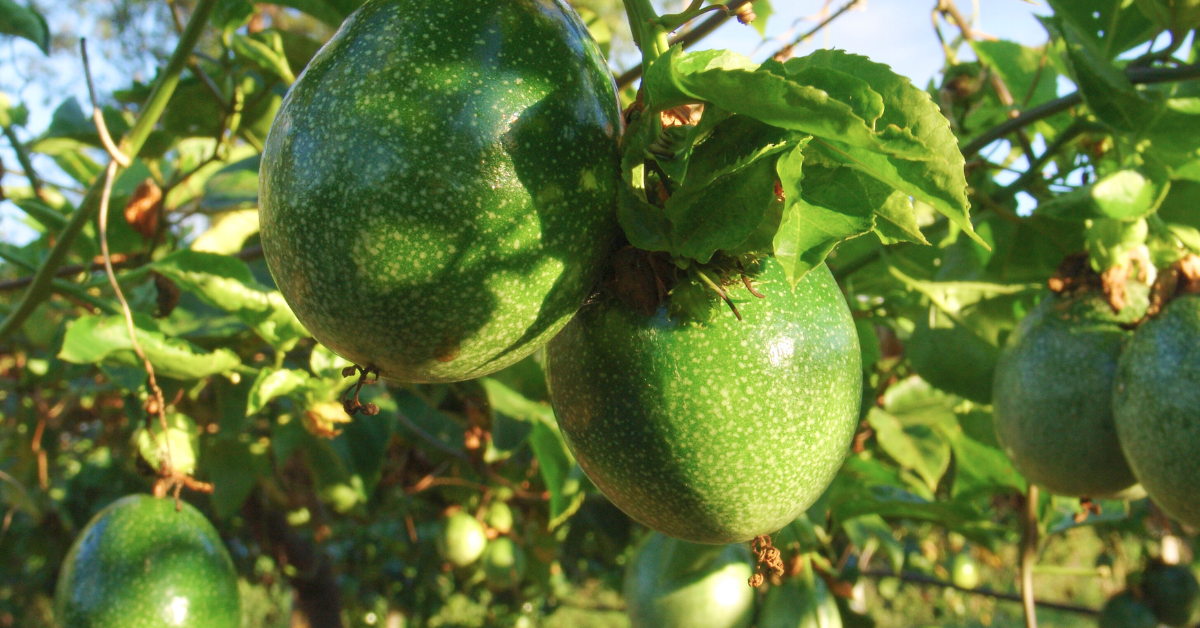How to Grow Passion Fruit From Seed
How to Grow a Ton of Passionfruit
Growing passion fruit from seed can be a rewarding process. Here’s a step-by-step guide on how to do it:
Materials Needed:
- Passion Fruit Seeds: You can obtain these from a ripe passion fruit.
- Seedling Trays or Pots: For germinating the seeds initially.
- Seed Starting Mix: A light, well-draining medium for sowing seeds.
- Watering can or spray bottle: For watering the seeds gently.
- Transparent plastic bag or dome: To create a mini greenhouse effect for humidity.
- Warm, Bright Location: Ideally with indirect sunlight.
Step-by-Step Instructions:
- Obtain the Seeds: Scoop out seeds from a ripe passion fruit. Rinse them to remove any pulp.
- Prepare the Seeds: Lay the seeds on a paper towel to dry for a day or two. This helps prevent mold during germination.
- Choose the Growing Container: Use seedling trays, small pots, or any container with drainage holes. Fill it with seed starting mix, which is light and sterile.
- Sow the Seeds: Plant each seed about ½ inch deep in the soil. You can sow multiple seeds per pot or cell, as germination rates can vary.
- Moisten the Soil: Water the soil gently so it’s evenly moist but not waterlogged. A spray bottle works well to avoid disturbing the seeds.
- Create Humidity: Cover the container with a transparent plastic bag or a dome to maintain high humidity. This mimics a greenhouse environment and helps with germination.
- Provide Warmth and Light: Place the container in a warm location with indirect sunlight. Ideal temperature for germination is around 70-85°F (21-29°C).
- Monitor and Water: Check the soil moisture regularly. Keep it moist but not soggy. Mist the soil if it begins to dry out.
- Germination: Passion fruit seeds typically germinate in 10-20 days, but it can take longer depending on conditions.
- Transplanting: Once seedlings have developed several leaves and are sturdy enough, they can be transplanted into larger pots or directly into the garden if the weather is warm enough.
- Caring for Seedlings: Provide plenty of sunlight (6-8 hours per day), water regularly, and protect from strong winds until they are established.
Tips for Success:
- Choose a Good Location: Passion fruit vines thrive in full sun and well-draining soil.
- Support for Vines: Plan for a trellis or other support structure as passion fruit vines are climbers.
- Pollination: Passion fruit plants need cross-pollination for fruit production, so consider planting more than one vine if possible.
How Long Does Passion Fruit Take to Grow from Seed?
Growing passion fruit from seed to fruit-bearing stage can take quite some time, typically around 1.5 to 2 years under optimal conditions. Here’s a breakdown of the timeline:
- Germination: Passion fruit seeds generally germinate within 10-20 days after sowing, though it can sometimes take longer depending on temperature and other growing conditions.
- Seedling Stage: After germination, the seedlings will grow slowly at first. It may take several months for them to develop into strong, healthy plants with several sets of true leaves.
- Vining and Growth Stage: Passion fruit vines grow vigorously once established. During the first year of growth, the vine will primarily focus on establishing itself and developing a strong root system. It will produce leaves and begin to climb or spread.
- Flowering: Typically, passion fruit vines begin to flower after about 6-12 months of growth, depending on conditions. The flowers are intricate and beautiful, and they can appear throughout the year in warm climates.
- Fruiting: The time it takes for passion fruit to bear fruit after flowering varies. In optimal conditions, fruiting can begin as early as 8-12 months after planting, but sometimes it may take longer, up to 18 months or more.
Factors Affecting Growth Time:
- Climate: Passion fruit grows best in warm climates with plenty of sunshine. In cooler regions or during winter months, growth may slow down.
- Care and Maintenance: Regular watering, feeding with fertilizer, and proper pruning can accelerate growth and fruit production.
- Variety: Some passion fruit varieties may fruit earlier or later than others. Check the specific characteristics of the variety you are growing.
Are Passion Fruit Seeds Easy to Grow?
Growing passion fruit from seeds can be both rewarding and straightforward, but it does require patience and attention to certain details. Here are some factors to consider regarding the ease of growing passion fruit seeds:
Factors Affecting Ease of Growing Passion Fruit Seeds:
- Germination Rate: Passion fruit seeds generally have a moderate to high germination rate if they are fresh and properly prepared. Seeds obtained from ripe fruits and cleaned of pulp tend to germinate well.
- Germination Conditions: Providing the right conditions for germination is crucial. Passion fruit seeds prefer warm temperatures (around 70-85°F or 21-29°C) and consistent moisture. Keeping the soil moist but not waterlogged and ensuring a humid environment (using a plastic bag or dome) can help with successful germination.
- Seedling Care: Once germinated, seedlings require careful attention. They need adequate light (preferably indirect sunlight), regular watering, and protection from harsh conditions like strong winds or extreme temperatures.
- Transplanting: As seedlings grow, they will need to be transplanted into larger pots or into the garden. Care should be taken during this process to minimize root disturbance.
- Establishment and Growth: Passion fruit vines are generally vigorous growers once established. They require a trellis or support structure to climb, ample sunlight (at least 6-8 hours per day), and well-drained soil. Regular feeding with fertilizer during the growing season can promote healthy growth.
How Do I Grow Passion Fruit in a Cold Climate?
Growing passion fruit in a cold climate presents challenges, but it’s possible with careful planning and attention to creating a suitable microclimate for the plants. Here’s a guide on how to grow passion fruit in a cold climate:
Choosing the Right Variety:
Select Cold-Hardy Varieties: Some passion fruit varieties are more tolerant of cooler temperatures. Look for varieties like Passiflora caerulea (Blue Passion Flower) or Passiflora incarnata (Maypop), which are more cold-hardy compared to tropical varieties.
Growing Conditions and Preparation:
- Location: Choose a location that receives maximum sunlight. South-facing walls or areas protected from cold winds are ideal.
- Soil Preparation: Passion fruit plants prefer well-draining soil with good fertility. Amend heavy clay soils with organic matter (compost, well-rotted manure) to improve drainage and nutrient content.
- Planting Time: Plant passion fruit in spring after the last frost date. This allows the plants to establish roots before winter.
- Growing in Containers: If your climate is extremely cold, consider growing passion fruit in large containers. This allows you to move the plants indoors or to a more sheltered location during winter.
Creating a Microclimate:
Protection from Cold: Provide protection from frost and cold winds. Options include:
- Mulching: Apply a thick layer of mulch around the base of the plant to insulate the roots.
- Covering: Use frost cloths, row covers, or even old blankets to cover the plants during frosty nights.
- Temporary Structures: Construct temporary hoop houses or cold frames to provide additional warmth and protection.
Heat Retention: Use thermal mass such as rocks or bricks around the base of the plants to absorb and release heat during cool nights.
Care and Maintenance:
- Watering: Passion fruit plants require regular watering, especially during dry periods. Ensure the soil remains consistently moist but not waterlogged.
- Feeding: Fertilize regularly during the growing season with a balanced fertilizer to promote healthy growth and fruiting.
- Pruning: Prune passion fruit vines in late winter or early spring to remove dead or damaged growth and to promote air circulation.
- Pollination: In cooler climates, hand pollination may be necessary to ensure fruit set. Gently transfer pollen between flowers using a small brush.
- Overwintering: Protect plants during winter by moving container-grown plants indoors to a cool, bright location or insulating them with mulch and covers.
Harvesting
Passion fruits typically ripen in late summer to early fall. Harvest fruits when they are fully colored and have dropped from the vine or are slightly wrinkled.






Leave a Reply